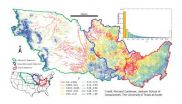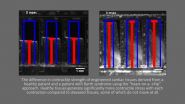(Press-News.org) Philadelphia, PA, May 12, 2014 – Corneal nerve fiber assessment has great potential as a tool to diagnose and monitor peripheral neuropathy induced by HIV, say scientists at the Johns Hopkins University School of Medicine. The results of their study are published in The American Journal of Pathology.
Although corneal nerve assessments have shown increasingly valuable as a replacement for epidermal nerve fiber evaluation in diabetic peripheral neuropathy, the evaluation of corneal alterations in tracking HIV-induced neuropathy has yet to be explored.
"The cornea is the most densely innervated tissue in the body, so corneal nerve assessment is extremely sensitive for detecting small sensory nerve fiber damage as compared to other tests including measurement of intra-epidermal nerve fibers in the skin," notes lead investigator Joseph L. Mankowski, DVM, PhD, who is Professor of Molecular and Comparative Pathobiology, Pathology, and Neurology at the Johns Hopkins University School of Medicine, Baltimore, MD.
Although not life threatening, HIV-induced peripheral neuropathy greatly compromises patient quality of life. Currently, skin biopsy is the accepted standard for measuring the loss of small, unmyelinated C fibers in the epidermis, one of the earliest detectable signs of peripheral nerve damage. However, skin biopsy is an invasive procedure, and ongoing assessment requires repeated surgical procedures. Electrophysiological testing to measure peripheral nerve conduction properties is not a viable alternative because current methods lack the sensitivity required to detect damage to small, unmyelinated fibers, especially in early stages of disease. Therefore, new sensitive, noninvasive methods of assessing small fiber nerve damage are urgently needed to detect and monitor peripheral neuropathy in HIV-infected individuals.
To study the pathogenesis of HIV-induced PNS disease, Jamie Dorsey, Research Technologist, and the research team led by Dr. Mankowski developed a simian immunodeficiency virus (SIV)-infected macaque model that closely reflects key peripheral nervous system (PNS) alterations seen in HIV patients with peripheral neuropathy. They sought to determine whether SIV infection leads to decreases in corneal nerve fiber density, and whether corneal nerve fiber density correlates with epidermal nerve fiber length counts, thereby setting the stage for follow-up investigation using corneal confocal microscopy.
"Moving to non-invasive and repeatable methods of nerve fiber measurements such as in vivo corneal confocal microscopy would enhance study of peripheral neuropathy by enabling early detection of damage, progression of nerve fiber deterioration, and enable assessment of therapeutic strategies in the SIV/macaque model," explains Dr. Mankowski. "Furthermore, adapting in vivo corneal confocal microscopy for use in tracking HIV-induced PNS damage in patients may be of great value to identify early PNS damage independent of performing skin biopsies."
To determine whether SIV infection leads to corneal nerve fiber loss, the researchers immunostained corneas for the nerve fiber marker βIII tubulin. They developed and applied both manual and automated methods developed by Jonathan Oakley, PhD, of Voxeleron to measure nerves in the corneal sub-basal plexus. These counting methods independently demonstrated significantly lower sub-basal corneal nerve fiber density among SIV-infected animals that rapidly progressed to AIDS as compared to slow progressors. Corneal nerve fiber density was also directly correlated with epidermal nerve fiber length.
Besides decreased corneal nerve fiber density, rapid SIV progressors had increased levels of SIV RNA, CD68-positive macrophages, and GFAP expression by glial satellite cells in the trigeminal ganglia, the location of the neuronal cell bodies of corneal sensory nerve fibers.
Together, these findings demonstrate that emerging noninvasive techniques to measure corneal nerve fiber alterations such as in vivo corneal confocal microscopy may be useful clinical tools to screen for and monitor progression of peripheral neuropathy in HIV-infected patients.
INFORMATION: END
New research sets stage for noninvasive monitoring of HIV-induced peripheral neuropathy
Corneal nerve fiber assessment proposed for managing patients with HIV-induced peripheral neuropathy, according to The American Journal of Pathology
2014-05-12
ELSE PRESS RELEASES FROM THIS DATE:
Current guidelines underestimate US cervical cancer incidence and older women's risk
2014-05-12
Rates of cervical cancer in American women may be higher than previously thought, and the disease may arise most often at an age when adequately screened women are advised to stop getting screened. The findings come from a new study published early online in CANCER, a peer-reviewed journal of the American Cancer Society. The results should be taken into consideration when the national guidelines for cervical cancer screening are reviewed.
Removal of the uterine cervix through a hysterectomy eliminates a woman's risk of developing cervical cancer, but previous estimates ...
Fourfold increase in the rate of diagnosed cases of Celiac disease in the UK
2014-05-12
Coeliac UK, the national charity for coeliac disease announces today, 12th May 2014, new research from the University of Nottingham that has found a fourfold increase in the rate of diagnosed cases of coeliac disease in the United Kingdom over the past two decades, but, still three quarters of people with coeliac disease remain undiagnosed. ¹
The National Institute of Health & Care Excellence (NICE) previously estimated that only 10 - 15% of those with coeliac disease had been diagnosed, however, this latest research by Dr Joe West from University of Nottingham, funded ...
Research suggests human microbiome studies should include a wider diversity of populations
2014-05-12
Microbial samples taken from populations living in the U.S. and Tanzania reveal that the microbiome of the human hand is more varied than previously thought, according to new research published in the journal Microbiology. These findings suggest that the 'standard' hand microbiome varies depending on location and lifestyle.
Results compared the microbes on the hands of women in the U.S. and Tanzania and found that organisms that have commonly been identified in prior human skin microbiome studies were highly abundant on U.S. hands, while the most abundant bacterial species ...
Ice-loss moves the Earth 250 miles down
2014-05-12
At the surface, Antarctica is a motionless and frozen landscape. Yet hundreds of miles down the Earth is moving at a rapid rate, new research has shown.
The study, led by Newcastle University, UK, and published this week in Earth and Planetary Science Letters, explains for the first time why the upward motion of the Earth's crust in the Northern Antarctic Peninsula is currently taking place so quickly.
Previous studies have shown the earth is 'rebounding' due to the overlying ice sheet shrinking in response to climate change. This movement of the land was understood ...
Green-energy community projects need better government backing
2014-05-12
Community-led sustainable energy projects are not taken seriously enough by the government, according to a new report from the University of East Anglia.
Published today, the report looks at how initiatives such as community-owned solar panels, wind turbines and hydro-electricity generators, as well as energy-saving projects, could make big differences in tackling climate change.
But while a 'Big Society' ethos has formed part of the legislative programme for the coalition government, and the UK Government's new Community Energy Strategy has been a big step forward ...
Atlas shows how genes affect our metabolism
2014-05-11
In the most comprehensive exploration of the association between genetic variation and human metabolism, researchers have provided unprecedented insights into how genetic variants influence complex disease and drug response through metabolic pathways.
The team has linked 145 genetic regions with more than 400 molecules involved in human metabolism in human blood. This atlas of genetic associations with metabolism provides many new opportunities to understand the molecular pathways underlying associations with common, complex diseases.
Metabolic molecules, known as metabolites, ...
Flexible supercapacitor raises bar for volumetric energy density
2014-05-11
Scientists have taken a large step toward making a fiber-like energy storage device that can be woven into clothing and power wearable medical monitors, communications equipment or other small electronics.
The device is a supercapacitor—a cousin to the battery. This one packs an interconnected network of graphene and carbon nanotubes so tightly that it stores energy comparable to some thin-film lithium batteries—an area where batteries have traditionally held a large advantage.
The product's developers, engineers and scientists at Nanyang Technological University (NTU) ...
Hydrologists find Mississippi River network's buffering system for nitrates is overwhelmed
2014-05-11
AUSTIN, Texas – A new method of measuring the interaction of surface water and groundwater along the length of the Mississippi River network adds fresh evidence that the network's natural ability to chemically filter out nitrates is being overwhelmed.
The research by hydrogeologists at The University of Texas at Austin, which appears in the May 11 edition of the journal Nature Geoscience, shows for the first time that virtually every drop of water coursing through 311,000 miles (500,000 kilometers) of waterways in the Mississippi River network goes through a natural ...
Patient stem cells used to make 'heart disease-on-a-chip'
2014-05-11
Cambridge, MA—Harvard scientists have merged stem cell and 'organ-on-a-chip' technologies to grow, for the first time, functioning human heart tissue carrying an inherited cardiovascular disease. The research appears to be a big step forward for personalized medicine, as it is working proof that a chunk of tissue containing a patient's specific genetic disorder can be replicated in the laboratory.
The work, published in Nature Medicine, is the result of a collaborative effort bringing together scientists from the Harvard Stem Cell Institute, the Wyss Institute for Biologically ...
Ocean winds keep Antarctica cold, Australia dry
2014-05-11
VIDEO:
Dr. Nerlie Abram, from the Australian National University, explains why ocean winds have stopped Antarctica from warming as much as other continents. Her research also explains droughts in Southern Australia.
Click here for more information.
New Australian National University-led research has explained why Antarctica is not warming as much as other continents, and why southern Australia is recording more droughts.
Researchers have found rising levels of carbon dioxide ...
LAST 30 PRESS RELEASES:
Numbers in our sights affect how we perceive space
SIMJ announces global collaborative book project in commemoration of its 75th anniversary
Air pollution exposure and birth weight
Obstructive sleep apnea risk and mental health conditions among older adults
How talking slows eye movements behind the wheel
The Ceramic Society of Japan’s Oxoate Ceramics Research Association launches new international book project
Heart-brain connection: international study reveals the role of the vagus nerve in keeping the heart young
Researchers identify Rb1 as a predictive biomarker for a new therapeutic strategy in some breast cancers
Survey reveals ethical gaps slowing AI adoption in pediatric surgery
Stimulant ADHD medications work differently than thought
AI overestimates how smart people are, according to HSE economists
HSE researchers create genome-wide map of quadruplexes
Scientists boost cell "powerhouses" to burn more calories
Automatic label checking: The missing step in making reliable medical AI
Low daily alcohol intake linked to 50% heightened mouth cancer risk in India
American Meteorological Society announces Rick Spinrad as 2026 President-Elect
Biomass-based carbon capture spotlighted in newly released global climate webinar recording
Illuminating invisible nano pollutants: advanced bioimaging tracks the full journey of emerging nanoscale contaminants in living systems
How does age affect recovery from spinal cord injury?
Novel AI tool offers prognosis for patients with head and neck cancer
Fathers’ microplastic exposure tied to their children’s metabolic problems
Research validates laboratory model for studying high-grade serous ovarian cancer
SIR 2026 delivers transformative breakthroughs in minimally invasive medicine to improve patient care
Stem Cell Reports most downloaded papers of 2025 highlight the breadth and impact of stem cell research
Oxford-led study estimates NHS spends around 3% of its primary and secondary care budget on the health impacts of heat and cold in England
A researcher’s long quest leads to a smart composite breakthrough
Urban wild bees act as “microbial sensors” of city health.
New study finds where you live affects recovery after a hip fracture
Forecasting the impact of fully automated vehicle adoption on US road traffic injuries
Alcohol-related hospitalizations from 2016 to 2022
[Press-News.org] New research sets stage for noninvasive monitoring of HIV-induced peripheral neuropathyCorneal nerve fiber assessment proposed for managing patients with HIV-induced peripheral neuropathy, according to The American Journal of Pathology


